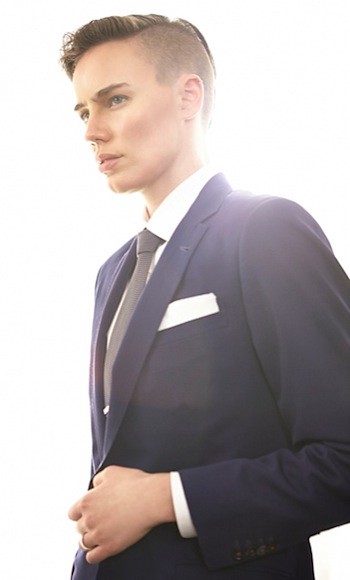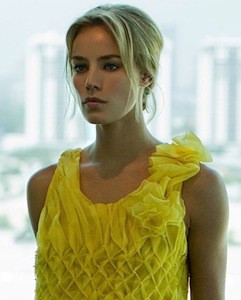Interview with Elliott Sailors, a Woman Working as a Male Model
by Britt Julious

Elliott Sailors is a 31-year-old woman who recently cut off all her hair and started working as a male model.
How did you get started in modeling? How long have you been a model?
When I turned 10, my dad took me to a model search. I don’t remember which one it was. It was in the fall of 2001 that I really started full time and moved to New York City. In terms of the idea of working as a male model, I don’t have a distinct memory of the moment, but it was inspired by Andrej Pejic. It was 2010 when I first saw his pictures. His ability to be seen as a man and a woman was really beautiful to me.
What were the initial challenges you faced as a model? Have they changed the longer you’ve worked?
The industry is constantly changing, so you’re always adapting to what is in at the time. Age is always a factor in terms of what is “right.” There’s always a lot of pressure on women to look as young as possible for as long as possible, and there isn’t the same sort of pressure for men. There’s a market for manly-looking men. It’s certainly easier for them to get work in their later years. For women, there isn’t so much of a market for women that look like… women. It exists, but [the work] isn’t as frequent.
What are some of the challenges of being a male model versus a female model?
I haven’t stopped working as a woman. Transformation isn’t impossible. Transformation is possible at any given moment. This is something I’m committing to because it has incited something for people that gets them excited. It’s bigger than fashion. I love fashion, but it’s bigger than that. I want people to show themselves in all the ways that you are or can be. Self-expression isn’t limited to what people want themselves to be.
Do you ever consider merely changing careers or moving out of an industry that focuses on beauty?
I actually majored in vocal performance in college, so I sing opera. I’ve been doing musical theater since I was considered as a model. It’s something I’ve considered and wanted to pursue as well as other parts of the fashion industry. There are numerous opportunities in the business side of it as well. But, I love my job and I’d like to make something with the rest of the time I have doing this. That’s what I’m excited about with this new look. You get to be a part of the high fashion world and tell a different story.
Why is it important for you to work as a male model in the high fashion world versus just commercial work?
Well, I was working commercially. I love those clients and working with those clients, but the inside is a very set construct of what you can do and what your role in the process of creating something bigger [entails].
I could have cut my hair short and still worked as a girl. It’s not like I needed to do [the haircut] or my career would go away. I chose to do that because it said something about your actions; because it shows models have something to say in our careers. A lot of [this job] is about what the agency says or what the booking agencies want. So in no way am I saying this to dismiss those people. But when you find yourself in a place that you can’t say what you want to say, you can say what you want to create. And you have to be able to take the risks that come with it.
I know that male models get paid less. I know that I don’t know all the pressures that a male model might face. I know there’s people in the fashion industry that don’t like it. But it’s really empowering to be able to create it by my own design. But at the same time being respectful of everyone I’ve worked with.
What kind of career do you see for yourself as a male model? What is the typical length of time a male model works in the industry? What is the post-modeling plan?
I dont have a cap on it. It’s not something that I’m just trying to test. I don’t know what the future will hold. There’s a tremendous amount of pressure out there. Like [the designer Coco] Chanel [brought] a menswear influence for women’s fashion. It was a really big deal at the time. The world of fashion has a lot to owe to her. I don’t have any type of ending date on this, but I’m always open to transformation as long as it’s possible, specifically with what message I want to get across.
Do you think there will be a rise in more androgynous looks infiltrating the modeling world?
The androgynous look is not brand new. There are a lot of beautiful men out there. I do think that it’s creating an opening. I’ve gotten flack for saying I’m trying to be a man. I’m not trying to be a man. But working in the modeling world, doing menswear as a woman, it’s different. There’s menswear and womenswear. There isn’t an option for androgyny. I think that it’s totally possible that it will start happening. They won’t separate it into men’s and women’s clothes. There will be something in between. Blurred lines won’t be a new concept. It’s true that there are a number of places in between male and female.

You’ve said that your husband is supportive but your mother is not. How did your husband first react? What is your mother opposed to?
My husband came with me for the haircut. He was the one taping the video. I don’t recall his first reaction. He was as excited as I was. All the way through, he’s right there. He’s the one asking, “What are we going to create next? How are we going to keep it going forward?” I don’t have a publicist or a PR person. It’s totally organic and happened itself. It’s been absolutely amazing.
With my mom, I communicated with her and asked if it was something she agreed with and I had her permission. But she said, I don’t agree with it. She’s not excited about it. I’m not going to be upset with people’s opinions about it. The relationship with us is the same as it’s always been. That’s what’s great about it. It’s about embracing humanity and showing that anything can be possible. It’s about bringing a vitality to the conversation: about gender, about fashion, about artistry, about all of them.
And what are you hoping to bring to the conversation?
[With androgyny,] people have questions in terms of how they feel about it. A lot of my guy friends are like, “Does that make you gay?” And I’m going to laugh. Some people have concerns and with other people, it’s not a concern with them. It’s about being clear and comfortable with who you are.
Gender and sexuality are two different things. There’s two different conversations: it’s about staying true to who you think you are and staying authentic to who you are and it’s not limited to how you were born or who you were yesterday. Who you are can be expansive; it can include many things. That’s what fashion is also about. We wear shirts, pants, dresses, skirts. We haven’t invented a new article of clothing. It’s about reinventing what people think of it and how they see it and what that article of clothing says. You get to find new ways of wearing it and showing who you are.
Previously: Interview with a High-Fashion Model Who Is Also Transgender
Photos by E. Adam Attia, TS Harrington Photography.
Britt Julious is Sade Adu’s number one fan. Follow her @britticisms.